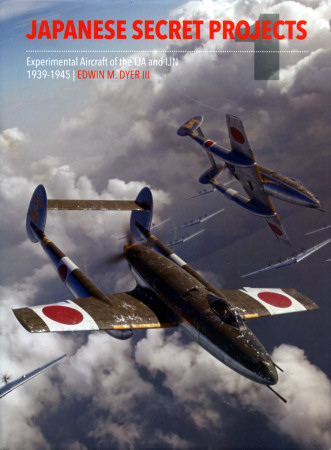
Japanese Secret Projects 1 Book Review
By David L. Veres
| Date of Review | April 2015 | Title | Japanese Secret Projects 1 |
|---|---|---|---|
| Author | Edwin M. Dyer III | Publisher | Crecy |
| Published | 2010 | ISBN | 9781857803174 |
| Format | 160 pages, hardbound | MSRP (USD) | $52.95 |
Review
"World War II 1946" enthusiasts! Gird yourselves for some cool, counterfactual fun!
The lavishly illustrated JAPANESE SECRET PROJECTS 1: Experimental Aircraft of the IJA & IJN 1939-1945 – thankfully reprinted by Crécy, and available in North America from Specialty Press – surveys at least 45 wartime Imperial prototype, project and "paper" designs.
Author Edwin M. Dyer kick-starts contents with an informative introduction and list of "abbreviations and glossary". Then come entries. Fighters. Bombers. Transports. And, naturally, suicide – shimpu/shimbu – machines.
Each features at least one excellent color plate, historical summary and data table. Specifications include powerplant, dimension, weights, performance, armament and, if applicable, deployment details.
Dyer admits that "more conventional designs or prototypes received a lower selection priority over more advanced concepts". Ditto for derivatives of operational designs – or purely experimental models. So you won't see, for instance, the Mitsubishi Ki-83, Nakajima Ki-116 or Kawasaki Ki-78 included. But you do see the Nakajima Ki-87, J1N Gekko and the crudely conventional Kikusai Ta-Go.
What's left is a mouth-watering selection of often-innovative efforts. The author first separates subjects by service – Imperial Japanese Army or Imperial Japanese Navy – then alphabetically arranges them by manufacturer. Following these come aircraft from neither service – or "joint projects".
Some designs – like the Kogiken Plan III Revised Light Bomber, Tachikawa Ki-94-I, Kugisho High-Speed "Projects" and Mitsubishi J4M Senden – resemble refugees from "Crimson Skies". How about that Mitsubishi-Payen Pa.400 and Suzukaze 20?
Others – like the Nakajima Ki-201 Karyu, Rikugun Ki-202 Syusui-Kai and Mitsubishi J8M – reflect Nazi Germany's late-war impact on advanced Japanese planning. Imagine a Hinomaru-bedecked Heinkel He 162 clone. It's here.
Still others – like the Kawasaki Ki-91 and Nakajima Fugaku – showcase Imperial efforts to redress the dearth of long-range heavy bombers.
Along the way, Dyer illumines much. You'll also see who, for instance, really benefited from German-Japanese technical exchanges. You'll also discover why he calls Japan's first jet "Kitsuka" – and not "Kikka". We linguists appreciate things like that!
From Ronnie Olsthoorn's superb cover illustration of Manshu Ki-98s intercepting Northrop B-35s to Crécy's concluding "Weapon Systems" notes, I thoroughly enjoyed this book. If you share my penchant for history's "what ifs", you will, too. Grab this reprint!
Recommended!
My sincere thanks to Specialty Press for this review sample!







